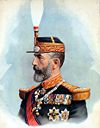- Romanian Old Kingdom
-
 King Carol I (ruled 1866–1914)
King Carol I (ruled 1866–1914)
The Romanian Old Kingdom (Romanian: Vechiul Regat or just Regat; German: Regat or Altreich) is a colloquial term referring to the territory covered by the first independent Romanian nation state, which was composed of the Danubian Principalities—Wallachia and Moldavia. It was achieved when, under the auspices of the Treaty of Paris (1856), the ad hoc Divans of both countries - which were under Imperial Ottoman suzerainty at the time - voted for Alexander Ioan Cuza as their prince, thus achieving a de facto unification under the name of the United Principalities of Moldavia and Wallachia. The region itself is defined by the result of that political act, followed by the inclusion of Northern Dobruja and the transfer of southern part of Bessarabia to Russia in 1878, the proclamation of the Kingdom of Romania in 1881, and the annexation of Southern Dobruja in 1913.
The term came into use after World War I, when the Old Kingdom became Greater Romania, after including Transylvania, Banat, Bessarabia, and Bukovina. Nowadays, the term mainly has a historical relevance, and is otherwise used as a common term for all regions in Romania included in both the Old Kingdom and present-day borders (namely: Wallachia, Moldavia, and Northern Dobruja).
See also
References
Categories:- Historical regions in Romania
- Kingdom of Romania
- Former countries in Romania
Wikimedia Foundation. 2010.



